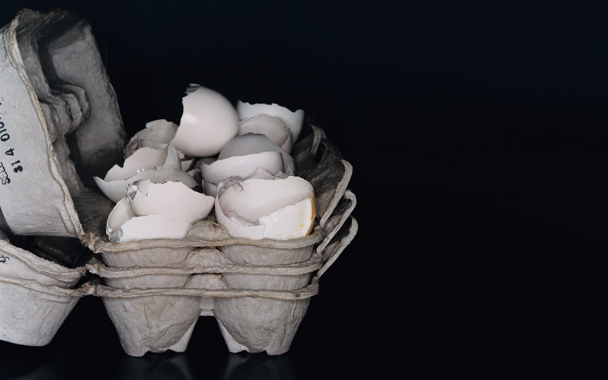I hit it once, just once, but it was beautiful. It was exam time and I was nervous, waiting for my turn. I had the proper fire. The heat felt right. I made smooth, swirling passes with my spatula, and when I rolled my pan over the plate, I knew it. Chef took a look at my omelet and squinted at me. He poked at it, pinched it, and then he knew, too. He called out to the class, “When you show me yours, I want it to look like this.” He set the plate in the window for the rest of the school to see, then turned around and gave me a quick wink.
Before Chef Skibitcky got ahold of my brain, I, like every other rational person, thought an omelet was something anyone can make. You throw eggs in a pan, stir them around, fold them in half, and put them on a plate. Done. No-brainer. It only gets interesting when you start tossing in other things—ham, some cheese, maybe a sautéed mushroom or two. Once, there was an omelet contest in my college cafeteria. The winner had it all wrapped up the minute he pulled an avocado and a wedge of Brie out of his bag. Young girls screamed and old men yelled. I stood and watched quietly, respecting him.
But there I was, years later, waking up at 2 a.m. for a class called a.m. Pantry. Still half asleep, I listened to Chef Skibitcky talk about French omelets, about how Escoffier himself used to test his prospective cooks by watching them make one. I perked up. I’d heard of roasting a chicken as a litmus test for cooks before, but an omelet? Really? What did they put in it?
Three eggs, salt, pepper, and a little butter. That’s all Chef had in front of him when he began his demonstration. I was skeptical. He started to swirl the liquid in the pan, his hands moving slowly at first, deliberately. He curled his wrist and snapped into a sweeping motion, gathering all the eggs back together with his spatula. He shook the handle gently, his movements getting gradually faster. There was something going on here. I saw how careful he was to watch and respond to the eggs, even if I didn’t know exactly what he was watching. He gave the pan a good whack with his fist and rolled it over a plate. The omelet slid out, tucking itself into a tidy cigar shape.
We passed it around to taste, and I couldn’t believe what I was eating. It was fantastically tender, almost slippery with creaminess. Not quite scrambled and not quite custard, it hit my mouth and dissolved in a cloud of butter and egg. I raised my fork for a third bite, but the other students started looking at me funny. Reluctantly, I passed the plate along.
I wanted more. It wasn’t just that it was delicious; it was that I realized that at that moment I was seeing for the first time something I thought I’d known my whole life. Like how, if you grew up with tomato-shaped rocks from supermarkets, your first explosive bite into a tomato off the vine in August shows you what a tomato really is.
Chef made another one, talking us through what he was seeing. It’s a precarious balancing act—you want the pan hot enough so the eggs don’t stick, but not so hot that they cook unevenly. You want to beat the eggs so that they’re fully blended, but not so much that they get foamy and dry out in the pan. You want to cook them gently so that they’re smooth and creamy, but not so soft that they weep. We weren’t even at the good part yet, and this was really starting to not seem like something anyone can make.
Quickly now, Chef shook and stirred until the very last drops of liquid egg hit the bottom of the pan at the exact same moment, cooking together to form a thin sheet that, when rolled, wrapped around the moist curd inside. “You want baby skin,” he kept saying. “Not elephant skin.” In other words, you have to set the skin just enough so that it can hold the omelet together, but not so much that it gets wrinkled and rubbery. And then you have to make sure that you cook it long enough so that it develops a little flavor, but not so long that it browns and loses its delicacy.
It was astounding how something so commonplace, so elemental, could have so many variables. You just have to learn to see all those variables, to recognize what effect every moment of heat, every motion of the hands has. To get back to that thing I tasted, I would have to know exactly what to look for and nail it every step of the way.
Three eggs, salt, pepper, and a little butter. That’s all there is in a classic French omelet, but it’s enough to keep reteaching me this vital lesson: Things are only simple when you’ve stopped asking the right questions of them, when you’ve stopped finding new ways to see them. Because what you find, when you learn how to find it, is that even simple things can be wonderfully, frustratingly, world-openingly complex.
It’s been half a decade since Chef taught me that lesson, since that morning when I went home and rolled out omelet after awful omelet until my roommate woke up to find plates covering every level surface in our kitchen. Eventually, I let my obsession revert to a healthy level of interest, until a couple of months ago, when I went out to breakfast with a friend. She thought the place was sketchy but ordered anyway, saying to me, “I figured, ‘How badly can you screw up an omelet?’”




 Pinterest
Pinterest






